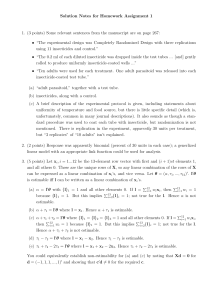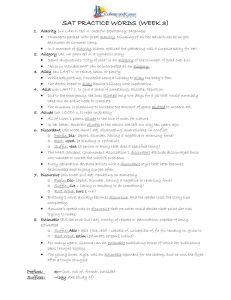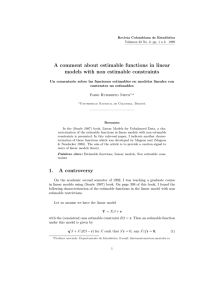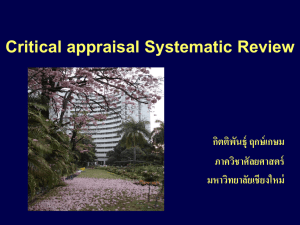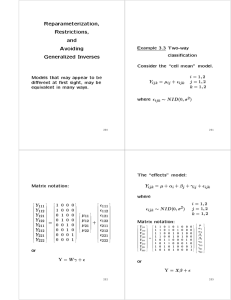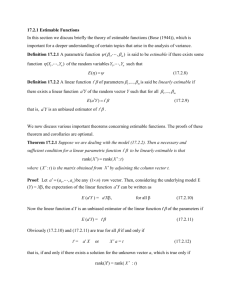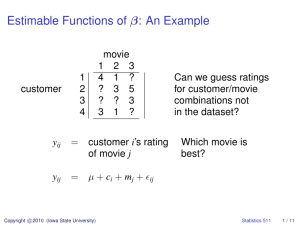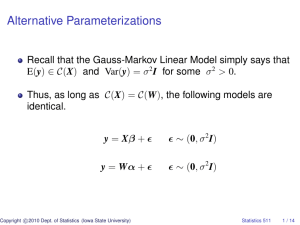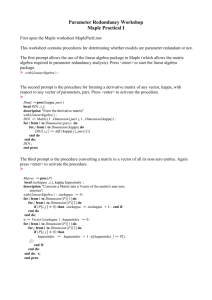ST A T 511
advertisement
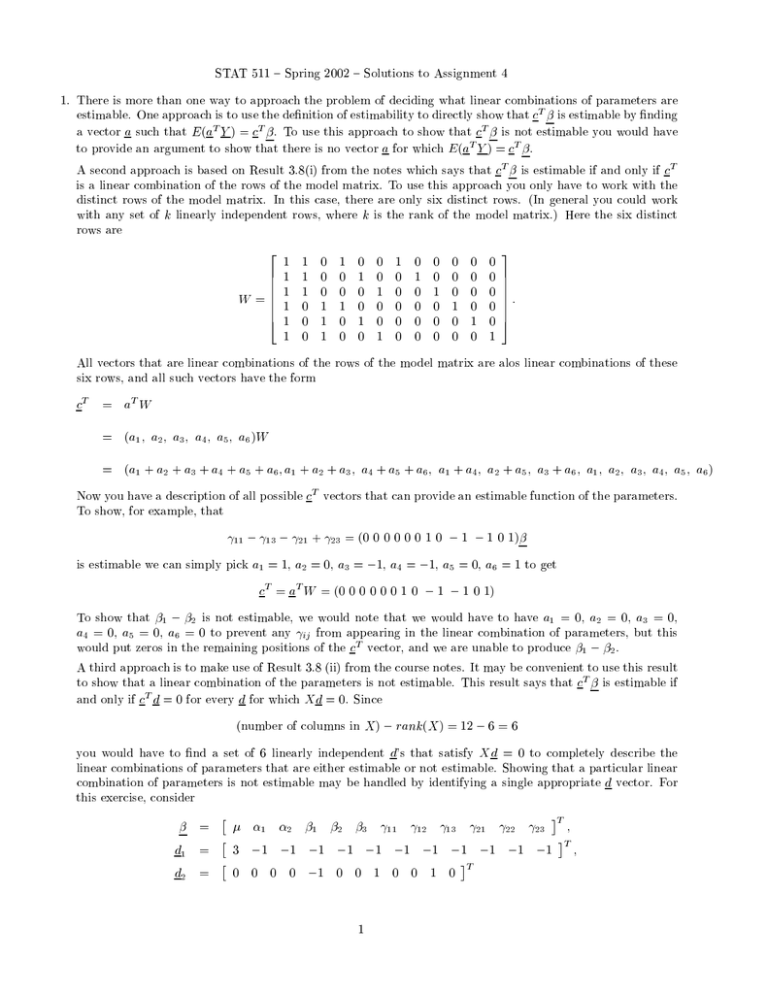
STAT 511 { Spring 2002 { Solutions to Assignment 4
1. There is more than one way to approach the problem of deciding what linear combinations of parameters are
estimable. One approach is to use the denition of estimability to directly show that cT is estimable by nding
a vector a such that E (aT Y ) = cT . To use this approach to show that cT is not estimable you would have
to provide an argument to show that there is no vector a for which E (aT Y ) = cT .
A second approach is based on Result 3.8(i) from the notes which says that cT is estimable if and only if cT
is a linear combination of the rows of the model matrix. To use this approach you only have to work with the
distinct rows of the model matrix. In this case, there are only six distinct rows. (In general you could work
with any set of k linearly independent rows, where k is the rank of the model matrix.) Here the six distinct
rows are
2
W=
6
6
6
6
6
6
4
1
1
1
1
1
1
1
1
1
0
0
0
0
0
0
1
1
1
1
0
0
1
0
0
0
1
0
0
1
0
0
0
1
0
0
1
1
0
0
0
0
0
0
1
0
0
0
0
0
0
1
0
0
0
0
0
0
1
0
0
0
0
0
0
1
0
0
0
0
0
0
1
3
7
7
7
7:
7
7
5
All vectors that are linear combinations of the rows of the model matrix are alos linear combinations of these
six rows, and all such vectors have the form
c
T
= aT W
= (a1 ; a2 ; a3 ; a4 ; a5 ; a6 )W
= (a1 + a2 + a3 + a4 + a5 + a6 ; a1 + a2 + a3 ; a4 + a5 + a6 ; a1 + a4 ; a2 + a5 ; a3 + a6 ; a1 ; a2 ; a3 ; a4 ; a5 ; a6 )
Now you have a description of all possible cT vectors that can provide an estimable function of the parameters.
To show, for example, that
11
13 21 + 23 = (0 0 0 0 0 0 1 0
1
1 0 1)
is estimable we can simply pick a1 = 1, a2 = 0, a3 = 1, a4 = 1, a5 = 0, a6 = 1 to get
c = a W = (0 0 0 0 0 0 1 0
T
T
1
1 0 1)
To show that 1 2 is not estimable, we would note that we would have to have a1 = 0, a2 = 0, a3 = 0,
a4 = 0, a5 = 0, a6 = 0 to prevent any ij from appearing in the linear combination of parameters, but this
would put zeros in the remaining positions of the cT vector, and we are unable to produce 1 2 .
A third approach is to make use of Result 3.8 (ii) from the course notes. It may be convenient to use this result
to show that a linear combination of the parameters is not estimable. This result says that cT is estimable if
and only if cT d = 0 for every d for which Xd = 0. Since
(number of columns in X )
rank(X ) = 12 6 = 6
you would have to nd a set of 6 linearly independent d's that satisfy Xd = 0 to completely describe the
linear combinations of parameters that are either estimable or not estimable. Showing that a particular linear
combination of parameters is not estimable may be handled by identifying a single appropriate d vector. For
this exercise, consider
=
d1 =
d2 =
1 2 1 2 3 11 12 13 21 22 23
3
1
1
0 0 0 0
1
1
1
1
1
1 0 0 1 0 0 1 0
1
1
T
1
1
T
1
;
T
;
and
2
X=
Note that Xd1 = Xd2 = 0.
6
6
6
6
6
6
6
6
6
6
6
6
6
6
6
6
6
6
6
6
6
6
6
6
6
6
6
6
6
6
4
1
1
1
1
1
1
1
1
1
1
1
1
1
1
1
1
1
1
1
1
1
1
1
1
1
1
1
0
0
0
0
0
0
0
0
0
0
0
0
0
0
0
0
0
0
1
1
1
1
1
1
1
1
1
1
1
1
0
0
0
0
0
0
1
1
1
0
0
0
0
0
0
0
0
0
1
1
1
0
0
0
0
0
0
1
1
0
0
0
0
0
0
0
0
0
0
1
1
1
0
0
0
0
0
1
1
1
1
1
1
1
0
0
0
0
0
0
0
0
0
0
0
0
0
0
0
0
0
0
1
1
1
0
0
0
0
0
0
0
0
0
0
0
0
0
0
0
0
0
0
1
1
1
0
0
0
0
0
0
0
0
0
0
0
0
0
0
0
0
0
0
1
1
1
0
0
0
0
0
0
0
0
0
0
0
0
0
0
0
0
0
0
1
1
0
0
0
0
0
0
0
0
0
0
0
0
0
0
0
0
0
0
1
1
1
1
3
7
7
7
7
7
7
7
7
7
7
7
7
7
7
7
7:
7
7
7
7
7
7
7
7
7
7
7
7
7
7
5
(a) Let c1 = [1; 0; :::; 0]T . Note that cT1 = but cT1 d1 6= 0; i.e., there exists a vector d such that Xd = 0 but
cT1 6= 0. Thus, by Result 3.8 (ii), is not estimable.
(b) Let c2 = [0; 0; 1; 0; :::; 0]T . Note that cT2 = 2 but cT2 d1 6= 0. Thus, by Result 3.8 (ii), 2 is not estimable.
(c) Let c3 = [0; 0; 0; 0; 1; 1; 0; :::; 0]T . Note that cT3 = 2 3 but cT3 d2 6= 0. Thus, by Result 3.9 (ii), 2 3
is not estimable.
(d) Let c4 = [0; :::; 0; 1]T . Note that cT4 = 23 but cT4 d1 6= 0. Thus, by Result 3.9 (ii), 23 = cT4 is not
estimable.
(e) Let c5 = [1; 0; 1; 0; 0; 1; 0; 0; 0; 0; 0; 1]T and a5 = [0; :::; 0; 1]T . Then, we have aT5 X = cT5 . Thus, by Result
3.9 (i), cT5 = + 2 + 3 + 23 is estimable. + 2 + 3 + 23 is the mean volume when fat 2 is used
with surfactant C and the OLS estimator is y23 .
(f) Let c6 = [0; 0; 0; 0; 0; 0; 1; 1; 0; 0; 0; 0]T . Then, cT6 = 11 12 but cT6 d2 6= 0. Thus, by Result 3.9 (ii),
11 12 = cT6 is not estimable.
(g) Let c7 = [0; 0; 0; 0; 0; 0; 1; 0; 1; 1; 0; 1]T and
a7 = [1=3; 1=3; 1=3; 0; 0; 0; 1=3; 1=3; 1=3; 1=3; 1=3; 1=3; 0; 0; 1=4; 1=4; 1=4; 1=4]T .
Then, we have aT7 X = cT7 . Thus, by Result 3.9 (i), cT7 = 11 13 21 + 23 is estimable.
11 13 21 + 23 = (dierence in mean bread volumes for surfactants A and C when fat 1 is used)
-(dierence in mean bread volumes for surfactants A and C when fat 2 is used)
This is an interaction contrast and the OLS estimator is y11 y13 y21 + y23
(h) Let c8 = [0; 0; 0; 0; 1; 1; 0; 1; 1; 0; 1; 1]T and
a8 = [0; 0; 0; 1=6; 1=6; 1=6; 1=6; 1=6; 1=6; 0; 0; 0; 1=2; 1=2; 1=4; 1=4; 1=4; 1=4]T .
Then, we have aT8 X = cT8 . Thus, by Result 3.9 (i), cT8 = (2 3 ) + 12 (12 + 22 13 23 ) is estimable.
(2 3 ) + 21 (12 + 22 13 23 ) is the dierence between the mean bread volume when surfactant B is
used and the mean bread volume when surfactant C is used, averaging across the fats giving equal weight
to each fat.
P
P
The OLS estimator is 21 2i=1 yi2 21 2i=1 yi3
(i) Let c9 = [0; 0; 0; 0; 0; 0; 0; 1; 1; 0; 1; 1]T . Note that cT9 = 12 + 22 13 23 but cT9 d2 6= 0. Thus, by
Result 3.9 (ii), 12 + 22 13 23 = cT9 is not estimable.
Many students simply reported "estimable" or "not estimable". Assignments may be graded in a generous
manner, but this will not earn full credit on an exam. You must be able to justy your answer using either
the denition of estimability or result 3.8 or result 3.9 from the course notes to show that you are not merely
quessing.
2
2. (a)
2
X=
6
6
6
6
6
6
6
6
6
6
6
6
6
6
4
1
1
1
1
1
1
1
1
1
1
1
1
1
1
1
0
0
0
0
0
0
0
0
0
0
1
1
1
1
1
90
95
100
105
110
90
95
100
105
110
3
7
7
7
7
7
7
7
7;
7
7
7
7
7
7
5
2
6
=6
4
1
2
3
7
7:
5
(b) Note that for the model matrix given in (a), Xd = 0 if and only if dT = w[ 1 1 1 0] for some scalar w.
(i)
(ii)
(iii)
(iv)
(v)
function
+ 2
1 2
+ T
estimable
No
Yes
Yes
Yes
No
Explanation
Here cT = [1 0 0 0] and w[ 1 1 1 1]c = w 6= 0 for w 6= 0.
use aT =[0 0 0 0 0 10 0 -9 0 0]
use aT =[-1/5 1/5 0 0 0 0 0 0 0 0]
use aT =[1 0 0 0 0 -1 0 0 0 0]
Here cT = [1 0 0 T ] and w[ 1 1 1 1]c = w + wT 6= 0 for w 6= 0
(vi) + 1 + (T 100)
Yes
use aT = [0:5 (T 100)=20; 0; 0; 0; 0:5 + (T 100); 0; 0; 0; 0; 0]
Many students had great diÆculty with part (vi). You could reason in the following way to nd a vector
a such that E (aT Y ) = + 1 + (T 100). Since this quantity involves + 1 and does not involve
+ 2 only use observations from runs with catalyst A. To estimate the slope you will need to use
observations from runs with catalyst A at two dierent temperatures. You could the observations from
runs with catalyst A, but we will consider the observations Y11 and Y15 from runs at 90 and 100 degrees
C. We need coeÆcients a1 and a5 such that
+ 1 + (T 100) = E (a1 Y11 + a5 Y15 ) = a1 ( + 1 + (90
(a1 + a5 )( + 1 ) + (10a5 10a1 )
Consequently, we need a1 + a5 = 1 and 10a5 10a1 = (T
a1 = 0:5 (T 100)=20 and a5 = 0:5 + (T 100)=20.
(c) The generalized inverse is shown in the solution to part (d).
(d) > X
..1
1
1
2
1
3
1
4
1
5
1
6
1
7
1
8
1
9
1
10
1
>
> A <> G <> G
A
1
1
1
1
1
0
0
0
0
0
B temp
0 -10
0
-5
0
0
0
5
0
10
1 -10
1
-5
1
0
1
5
1
10
t(X) %*% X
ginverse( A )
[,1]
[,2]
[,3] [,4]
[1,] 0.04444444 0.02222222 0.02222222 0.000
[2,] 0.02222222 0.11111111 -0.08888889 0.000
[3,] 0.02222222 -0.08888889 0.11111111 0.000
3
100)) + a5 ( + 1 + (110
100)) =
100). Solvong these two equations, we obtain
[4,] 0.00000000 0.00000000
attr(, "rank"): [1] 3
>
> # (i)
AGA = A
> round( A %*% G %*% A - A,
..1 A B temp
..1
0 0 0
0
A
0 0 0
0
B
0 0 0
0
temp
0 0 0
0
>
> # (ii) GAG = G
> round( G %*% A %*% G - G,
[,1] [,2] [,3] [,4]
[1,]
0
0
0
0
[2,]
0
0
0
0
[3,]
0
0
0
0
[4,]
0
0
0
0
>
> # (iii) (AG)^T = AG
> round( t(A %*% G) - A %*%
..1 A B temp
[1,]
0 0 0
0
[2,]
0 0 0
0
[3,]
0 0 0
0
[4,]
0 0 0
0
>
> # (iv) (GA)^T = GA
> round( t(G %*% A) - G %*%
[,1] [,2] [,3] [,4]
..1
0
0
0
0
A
0
0
0
0
B
0
0
0
0
temp
0
0
0
0
(e)
0.00000000 0.002
5 )
5 )
G , 5 )
A , 5 )
Thus, the (X T X )( ) generated from ginverse() in S-plus satises the four properties of the MoorePenrose inverse.
> b <- ginverse( t(X) %*% X ) %*% t(X) %*% Y
> b
[,1]
[1,] 20.40
[2,] 8.00
[3,] 12.40
[4,] 0.85
(f)
4
20
25
Yield
30
35
40
Problem 2 on Assignment 4
-10
-5
0
5
Temperature-100
10
Based on the gure above, we can see that the observed data conform nicely to the two parallel lines
corresponding to catalysts A and B (Same ^ = :55). Consequently, the observed data seem to agree with
the proposed model. You could also examine residual plots.
(g) No. Note that the projection matrix PX = X (X T X ) X T is invariant to the choice of generalized inverse
(X T X ) . Then, the estimates for the mean yield Y^ = PX Y are also invariant and thus unchanged even
if dierent solutions to the normal equations are used.
3. (a)
(1T 1) 1 1T Y = (1=n)
2 X
5
X
Y = Y ;
ij
n = 10:
::
i=1 j =1
(b)
(c)
P1 P1 = 1(1T 1) 1 1T 1(1T 1) 1 1T = 1(1T 1) 1 1T
= P1 :
^ = P1 Y = 1(1T 1) 1 1T Y = 1Y::
Y
(d)
YT Y =
=
=
=
=
=
YT (P1 + I P1 )Y
YT P1 Y + YT (I P1 )Y
YT P1 P1 Y + YT (I P1 )(I P1 )Y
(P1 Y)T P1 Y + f(I P1 )YgT (I P1 )Y
^TY
^ + (Y Y)
^ T (Y Y)
^
Y
2 X
5
X
Y^ +
2
2 X
5
X
(Yij
ij
i=1 j =1
Y^ )2
i=1 j =1
ij
= SSmodel;uncorrected + SSresiduals
(e)
YT P1 Y =
=
=
=
5
YT P1 P1 Y
(P1 Y)T P1 Y
(1Y:: )T 1Y::T
nY::2
(f)
YT Y = YT (P1 + Px P1 + I Px )Y
= YT P1 Y + YT (Px P1 )Y + YT (I
Px )Y
(g)
YT (Px
P1 )Y = YT (I P1 + Px I)Y
= YT (I P1 )Y YT (I Px )Y
= f(I P1 )YgT (I P1 )Y f(I Px )YgT (I
^ T (Y Y)
^
= (Y 1Y:: )T (Y 1Y:: ) (Y Y)
=
2 X
5
X
(Yij
i=1 j =1
Y )2
2 X
5
X
(Yij
::
i=1 j =1
= SSresiduals;commonmeans;model
6
Px )Y
Y^ )2
ij
SS
residuals;problem2
